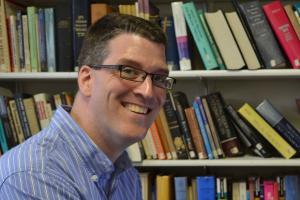Resources

My journey into online education was indirect. I started out as a missionary-graduate student who was working on a Master of Arts degree from overseas. My first distance learning class was on cassette tape, but soon after our school developed online courses in which the primary interaction was through listservs. A few years later we saw the emergence of learning management systems (LMS) such as Embanet, WebCT, and Blackboard. Remember those days? In spite of the primitive digital medium we used, the courses worked. I attained both a broad and deep level of knowledge of Christian thought in these courses because our professor grounded his assignments and email discussions on good educational theory. At the time I hadn’t studied the literature of educational theory, but as my own post-missionary career began to overlap significantly with online education, I was determined to gain a better understanding of what kind of theory leads to effective online courses. While combing through the literature, I noticed that there seemed to be a philosophical connection between constructivism and distance learning. I kept digging to find out the reason behind this affinity between the two; at one point, I pulled philosophical layers back to Jean-Jacques Rousseau. What I found was that there have always been advocates for “learning by doing” and there have always been those who have regarded experiential learning as anathema. Emerging from the cross-fire, however, was John Dewey and his integration of the scientific method with social science research during the Progressivism period in the early 20th century. In Experience and Education (1938), Dewey described what happens when one’s life experiences intersect with new concepts or skills. He called this intersection the “learning situation” (pp 42-43). His book did not provide a diagram, but I imagine that if Dewey had sketched out this phenomenon it would have looked something like this: Note that the horizontal axis represents the continuity of past, present, and future experiences. The vertical axis represents a continuum of interactions ranging from personal reflection to interaction with people, places, and events. The two axes can move up and down and side to side depending on the connecting point between experience and interaction, but where the two meet is where the learning situation occurs. The metacognition swirl is a bit anachronistic, but I wanted the diagram to indicate the place where deeper reflection about one’s learning experience might take place. This simple “learning situation” as described by Dewey illustrates well the dynamic between student experiences and learning new concepts and skills. As I considered how to translate the learning situation into online education, I wanted to design courses that made use of learners’ past experiences and current contexts as resources for learning. Steve and Mary Lowes (2010) also contributed to my thinking for how to see the individual contexts of students separated by time and space as unique and relevant learning laboratories. (See also Bronfenbrenner 1979). The thought world of experiential learning and my applications of it to online course design and facilitation led me to the next step of my quest when McGaughy, McDonald, and I (2018) completed a qualitative research project based on the following research question: “In what ways does the interaction of past experiences and present community impact learning online?” We selected an online course used for study abroad programs at our institution, and through a triangulation of course evidence and a survey, we looked for common themes that addressed experiences of the students and their learning environment online. Three salient themes emerged: flexibility, travel, and communication. The theme flexibility represented both time and space. Students in the online program were empowered to study when and where it was most beneficial to their learning experiences. Although flexibility did not describe how experiences directly impacted learning, the participants’ descriptions of their flexible study times and locations shed light onto the intersection of context and learning. Travel tied directly into the research question. Participants reported how previous travels helped them relate to the topics of their online course. They also mentioned how encounters with people overseas opened their minds to intercultural communication concerns as well as recognizing variations of worldview. Expressions like “really made me think” and “my eyes were opened” related evidence for real-world experiences that had a direct impact on learning. Communication provided the bridge between the online medium and context of the student. As participants discussed matters related to communication, they would reflect on discussion boards, interactions with their professor, as well as face-to-face conversations with people at their sites. Interactions with students online led to “new insights” and “different points of view.” Conversations with people outside of class in their context also contributed to students’ learning new ideas and perspectives. This study provided evidence of Dewey’s learning situation in an online course, and the implications for distance education are important. As we imagine how to design, create, and facilitate online courses, we need to eradicate from our minds the mythological student who has been closed off from human contact and is unable to make cognitive connections between what they are learning and how it applies in their contexts. Rather, imagine our students as individuals who are surrounded by a learning laboratory, but also connected to a network of classmates in a shared digital learning space. Students who take courses online deserve creative course designs that maximize the online tools as well as point them to real-time, face-to-face learning experiences. As we envision the road ahead in the age of education without walls, consider these words of Dewey, “. . . it is not of new versus old education nor of progressive against traditional education but a question of what anything whatever must be to be worthy of the name education” (1938, p 90). Works cited: Bronfenbrenner, U. (1979). The ecology of human development. Cambridge, MA: Harvard University Press. Dewey, J. (1938). Experience and education. New York: Touchstone. Lowe, S. D., & Lowe, M. E. (2010). Spiritual formation in theological distance education: An ecosystems model. Christian Education Journal, 3, 7(no. 1), 85-102. Westbrook, T. P., McGaughy, M., & McDonald, J. (2018). An investigation into the implications of Dewey’s “Learning Situation” for Online Education. NET: An eJournal of Faith-Based Distance Learning, 2.

My most recent tweet (of almost ten thousand) was 40 weeks ago. My most recent Facebook status update (except for a brief "thank you" for birthday wishes in July) was 46 weeks ago. The previous three years, however, I have taught my main introductory course, "Introduction to the Hebrew Bible," as an open, freely-available, online event built almost entirely on social media, especially Twitter, WordPress blogs, and Google Docs. This was the Open Old Testament Learning Event, or "OOTLE." My use of social media in higher education was based on a belief in the power of making for learning, and on a utopian vision for the internet that was based on my own experience. Eventually, the failures of the major centralized social-media platforms to proactively account for systemic abuse of marginalized users led me to abandon our pioneer outpost of open learning, and to retreat with my students back into the familiar confines of "the devil I know," the closed learning management system or "LMS." Many educators will have some familiarity with the learning theory "constructivism" (sometimes "constructionism"). According to this model, learners do not simply "acquire" knowledge, but rather always "construct" knowledge by synthesizing their existing understandings with new information or insights. Less well known, however, is that according to a constructivist model, this knowledge-making is more likely to occur where learning happens socially and where learners collaboratively build artifacts that are publicly shared. As the internet age took hold, and learners began increasingly to build their knowledge in a world of information excess rather than a world of information scarcity, it was often remarked that content on the internet was composed by perhaps 1% of internet users. Perhaps 9% of users interact with this content, and some 90% only passively consume content. This is sometimes called the "1% rule" or the "90/9/1 rule." From computer science to the humanities, educators began to embrace the power of "maker culture" to unleash the potential of constructivist learning in individuals, and to remake the internet in the image of the whole body of its users. It was in this context that the use of social media in higher education began to spread like fire: classroom Twitter "back channels" or weekly synchronous "Twitter chats"; blogging assignments on open web platforms like WordPress; presentation or digital storytelling on YouTube; and Facebook groups and pages. Then in 2014 came "Gamergate," a campaign of organized harassment against female game designers and game enthusiasts, including frequent credible threats of sexual violence and murder. Gamergate provided a playbook for white supremacist organizations and eventually, it seems, even for Russian interference via "troll farms" in 2015-16 U.S. political discourse on Twitter, Facebook, and YouTube. ("Trolling" describes skillful, media-savvy practices in derailing or redirecting discourse, whether for pleasure, malice, or profit.) Even among social-media users apparently uninvolved in these large events, in became clear that the codes of conduct and anti-harassment policies dictated by the young, white "tech bros" of social media (Jack Dorsey of Twitter, Mark Zuckerberg of Facebook), could not provide marginalized users anything like the safe environment enjoyed by privileged users less likely to be targeted. This remains the case, skewed as these policies are toward favoring "free speech" in an absolute sense and leaving users to block malicious actors as best they can . . . only possible, of course, after the malicious acts have occurred. Even we relatively privileged users became accustomed to weary acknowledgements that "of course Twitter is a cesspool, but . . . " Eventually, "But. . . “ became for me, and for many educators in my circles, "But what?" and then "But nothing." It had become impossible to offer my learners a reasonable guarantee that they would enjoy equitable social-media experiences, regardless of how they chose to present their race, gender, sexual self-understanding, class, or other differences. As I consider shepherding learners again into the social-media space ("not yet, not yet"), I remain optimistic about decentralized platforms like Mastodon. It is clear that the "one size fits all" approach to codes of conduct and anti-harassment policies (as on Twitter and Facebook) is untenable. On Mastodon, a radical free-speech, no-holds-barred community can have its minimalistic code of conduct, while a more proactive, highly-moderated community can choose to federate with that group, or not. I have not given up on a commitment to learning via collaborative construction of publicly available artifacts, but I am once bitten . . .and will twice be shy of any monetized, centralized platform.